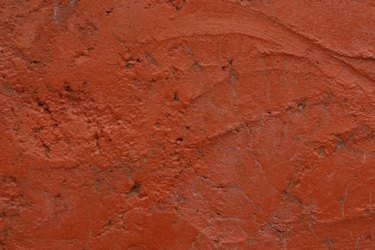
Clay is a raw, malleable material that is used in preparing ceramic items and sculptures. Clay can be categorized according to its composition and the temperatures it is fired at. Terra-cotta is a term that refers to fired clay, typically unglazed, but it may also refer to the red-brown color that earthenware clays get after kiln firing to low temperatures.
Clay
Video of the Day
Clay is a general term used to refer to materials that are used for modeling and creating three-dimensional objects. Clay may be made up of natural materials such as minerals, but there are also types of clay that are made of synthetic materials such as polymer. Earthenware, stoneware and kaolin are the most frequently used types of organic clay. Polymer clay is ideal for projects for children and beginners.
Video of the Day
Terracotta
Terra-cotta is an Italian term that means "baked earth." Terra-cotta refers to a glazed or unglazed piece of ceramic made using organic clay fired in a potter's kiln. Archaeologists and art historians refer to clay objects such as sculptures or tiles, made without a potter's wheel as terra-cotta. Objects made on the potter's wheel are called pottery. Terra-cotta also refers to the color of fired earthenware clay that contains a high amount of iron oxide.
The Difference Between Clay and Terra-cotta
The difference between clay and terra-cotta is that clay is the raw material, while terra-cotta is clay that is already modeled and fired. Typically, terra-cotta objects may be made of any types of organic clay, but earthenware clay has the brown-orange color that is also known as terra-cotta. Terra-cotta products are fired to low temperatures and result in a more porous and permeable surface.
Types of Organic Clay
The most well known types of clay include kaolin, earthenware and stoneware. Kaolin is ideal to make dinnerware and figurines. Kaolin is the purest clay and is not as malleable as other types of clay. Porcelain is fired to higher temperatures than other types of clay (up to 2550 degrees Fahrenheit). The firing vitrifies the material. Stoneware is fired to temperatures ranging from 2100 to 2300 degrees Fahrenheit and is used in making dinnerware.
Earthenware is made up of several minerals such as iron oxide, White or buff earthenware materials are also available, but not as common as red. Earthenware is ideal for hand-building and sculpting. Red earthenware contains more impurities and is a low-fire clay, fired to temperatures between 1700 and 2100 degrees Fahrenheit. The low temperatures preserve the red-brown color in earthenware; the color changes to dark brown if the temperature increases. Due to the low firing temperature red is more permeable than and not as sturdy as vitrified kaolin or stoneware.